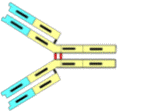Search Cidpusa web
IVIG Protocol
😏cidpusa.orgIVIG protocol,
IgG introduction

Introduction
Immunoglobulins are proteins produced by cells of the B lymphocyte. Immunoglobulin molecules are antibodies that react with specific antigens, although in many circumstances. Immunoglobulin preparations from human blood were first used in clinical medicine in 1952 to treat immune deficiency conditions. At that time, the only available preparations required intramuscular administration. In the past decade, several immunoglobulin preparations for intravenous administration have become available. Although initially used for immune deficiency states, intravenous immunoglobulin (IVIG) has also been utilized as a prophylactic and therapeutic reagent in a variety of other conditions. The use of IVIG has undergone tremendous growth in the past several years. This rapid growth in use is the result of improvements in the preparations of IVIG, which have led to reduced morbidity and reports of its benefits in a number of unexpected circumstances. IVIG has been used in such diverse diseases as primary immunodeficiencies, pediatric AIDS, infections in low birth weight infants, bone marrow transplantation, chronic lymphocytic leukemia, idiopathic thrombocytopenic purpura, Kawasaki syndrome, and demyelinating polyneuropathies. However, important questions regarding its use still remain.
In the various disease states in which IVIG has been used, the following questions were considered:he data to support the efficacy of IVIG in these circumstances?
After a day and a half of presentations by experts in the field and discussion by the audience, a consensus panel drawn from specialists and generalists from the medical profession and related scientific disciplines, clinical investigators, and public representatives considered the evidence and came to the conclusions on the following pages.
What Are the Data To Support the Efficacy of IVIG in These Circumstances?
Primary Immunodeficiencies
The beneficial effects of intramuscular (IM) injection ofThe beneficial effects of intramuscular (IM) injection of immune globulin (IG) in the prophylactic treatment of patients with primary immunodeficiency syndromes have been well established. Early studies based on small sample sizes have indicated that almost any desired blood level of IgG can be obtained by use of intravenous immunoglobulin and that infection rates are reduced by use of IVIG as compared with IM IG. IVIG has been shown to ameliorate chronic sinopulmonary disease that developed in patients on long-term IM IG. There is a suggestion that chronic enterovirus meningoencephalitis in patients with X-linked agammaglobulinemia may be less frequent in those receiving prophylactic IVIG as compared with historical data in which IM IG was used. Hence, IVIG has become the current standard in clinical practice for replacement therapy of patients with primary immunodeficiencies (e.g., X-linked agammaglobulinemia and common variable immunodeficiency and immunoglobulin subclass deficiency in which deficiencies of antibody production to common pathogens can be demonstrated). Studies have shown that maintenance of a trough level of 500 mg/dL is beneficial. Dose ranges of 200-800 mg/kg/mo have been shown to be effective, but dose or frequency of infusions must be tailored to the individual patient, because half life of infused IVIG varies widely.
😏